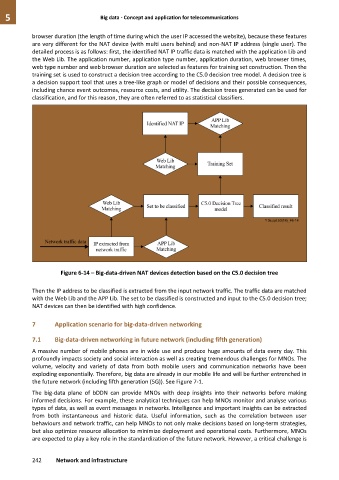Page 250 - Big data - Concept and application for telecommunications
P. 250
5 Big data - Concept and application for telecommunications
browser duration (the length of time during which the user IP accessed the website), because these features
are very different for the NAT device (with multi users behind) and non-NAT IP address (single user). The
detailed process is as follows: first, the identified NAT IP traffic data is matched with the application Lib and
the Web Lib. The application number, application type number, application duration, web browser times,
web type number and web browser duration are selected as features for training set construction. Then the
training set is used to construct a decision tree according to the C5.0 decision tree model. A decision tree is
a decision support tool that uses a tree-like graph or model of decisions and their possible consequences,
including chance event outcomes, resource costs, and utility. The decision trees generated can be used for
classification, and for this reason, they are often referred to as statistical classifiers.
Figure 6-14 – Big-data-driven NAT devices detection based on the C5.0 decision tree
Then the IP address to be classified is extracted from the input network traffic. The traffic data are matched
with the Web Lib and the APP Lib. The set to be classified is constructed and input to the C5.0 decision tree;
NAT devices can then be identified with high confidence.
7 Application scenario for big-data-driven networking
7.1 Big-data-driven networking in future network (including fifth generation)
A massive number of mobile phones are in wide use and produce huge amounts of data every day. This
profoundly impacts society and social interaction as well as creating tremendous challenges for MNOs. The
volume, velocity and variety of data from both mobile users and communication networks have been
exploding exponentially. Therefore, big data are already in our mobile life and will be further entrenched in
the future network (including fifth generation (5G)). See Figure 7-1.
The big-data plane of bDDN can provide MNOs with deep insights into their networks before making
informed decisions. For example, these analytical techniques can help MNOs monitor and analyse various
types of data, as well as event messages in networks. Intelligence and important insights can be extracted
from both instantaneous and historic data. Useful information, such as the correlation between user
behaviours and network traffic, can help MNOs to not only make decisions based on long-term strategies,
but also optimize resource allocation to minimize deployment and operational costs. Furthermore, MNOs
are expected to play a key role in the standardization of the future network. However, a critical challenge is
242 Network and infrastructure

